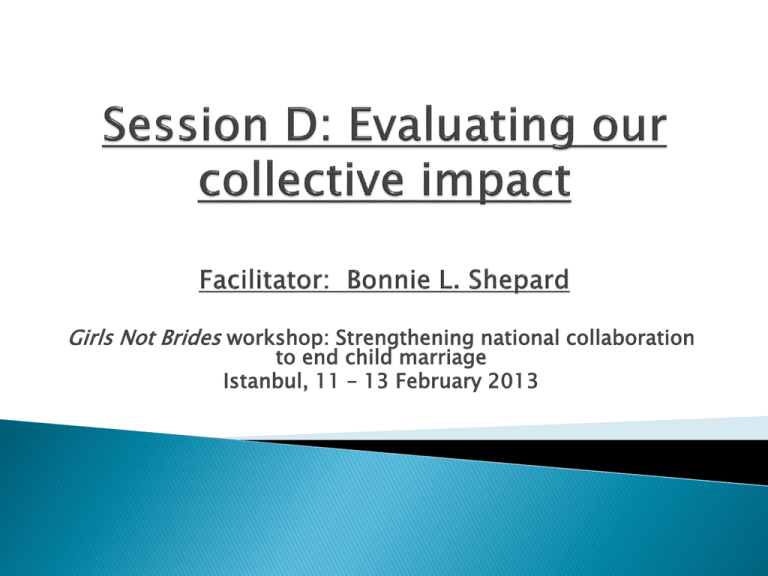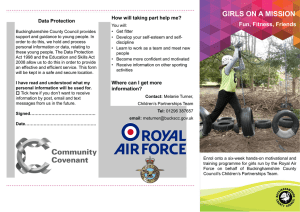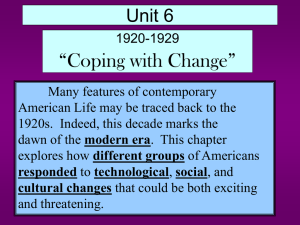Bonnie-Shepard
advertisement

Girls Not Brides workshop: Strengthening national collaboration to end child marriage Istanbul, 11 – 13 February 2013 Objective: Partnerships gain new, feasible Presentation and Group Discussion: 30 min. ideas on how to evaluate collective impact. ◦ Basic M&E concepts as applied to networks ◦ Examples of M&E solutions from Secretariat and members Small Group Exercise: 30 min. ◦ Each group of 8-9 takes two-three examples of network results, and proposes M&E framework. Report back & Discussion: 25 min. Wrap-up: Suggestions for follow-up: 5 min © Bonnie L. Shepard Girls not Brides Partnership meeting, Feb. 11-13, 2013 We work hard, we care passionately about our mission, and resources are scarce. Therefore, it is crucial to know ◦ Whether all our efforts and resources are making a difference ◦ How we could be making even more of a difference. Evaluation must be driven by your deepest hopes for success, and not by donors. ◦ Yet it is terribly demoralizing if you can’t convince others – including donors – of your successes For networks, it can be challenging to identify the successes of the network – distinct from but linked to the successes of the members. © Bonnie L. Shepard Girls not Brides Partnership meeting, Feb. 11-13, 2013 RESPONDS TO QUESTIONS ABOUT VALUE (Impact or Outcome evaluation) ◦ Did the network achieve its objectives? ◦ What value does a network add to the individual efforts of its members? (more than the sum of the parts) ENABLES LEARNING FROM EXPERIENCE TO IMPROVE STRATEGIES (Process or Formative Evaluation) ◦ What explains successes or failures to achieve objectives? ◦ How could the network improve its results and functioning? SYSTEMATIC DATA COLLECTION AND ANALYSIS ◦ All staff/participants make intuitive judgments about value and learning. ◦ Evaluation – whether internal or external -- seeks to make judgments valid, reliable, and transparent. © Bonnie L. Shepard Girls not Brides Partnership meeting, Feb. 11-13, 2013 result? goal? outcome? impact? objective? target? strategy? effectiveness? baseline? indicator? measure? output? achievement? activity? input? benchmark? theory of change? © Bonnie L. Shepard Girls not Brides Partnership meeting, Feb. 11-13, 2013 Theory of change: Explain why and how each outcome/result leads to the next in pathways to the ultimate goal (ending child marriage) Impact: change at a population level. e.g. decrease in child marriage rates. Result/outcome: A desired change in a state or condition as a result of your activities. Activity: Everything that a program actually does or produces to lead to the expected results: e.g. run a training workshop, write a manual, hold community meetings. © Bonnie L. Shepard Girls not Brides Partnership meeting, Feb. 11-13, 2013 Objectives are time-bound, realistic, and measurable statements of the results/outcomes you plan to achieve. Some objectives use quantitative measures, called “indicators,” with baselines and targets: ◦Indicators are used for results that make sense to count, that is, significant increases or decreases in numbers or percents. ◦Example: The number of network members (indicator) will grow from 10 in 2012 (baseline) to 30 (target) in 2014. © Bonnie L. Shepard Girls not Brides Partnership meeting, Feb. 11-13, 2013 Other specific objectives describe equally measurable results that are significant steps in the pathway to the ultimate goal. ◦Example: (global level) Post-2015 international development frameworks will include rates of child marriage as an indicator along with a time-bound target for reduction. ◦Example: (national level) By 2014, the Ministries of Family, Justice, and Health will send representatives regularly to the meetings of the national coalition to end child marriage. © Bonnie L. Shepard Girls not Brides Partnership meeting, Feb. 11-13, 2013 GOAL (e.g. ending child marriage) BLACK BOX Activities: Community meetings to inform about the harm caused by child marriage © Bonnie L. Shepard Girls not Brides Partnership meeting, Feb. 11-13, 2013 What are the pathways to your goals and vision? ◦ Consider the complexity of political and social change processes & pathways ◦ How will you know if you are making progress on your chosen pathway? “Contribution, not attribution” ◦ The more long-term the objective, the more complex the process of change ◦ Your activities have contributed to change, but rarely can you say that your efforts are the sole cause of change Only immediate results can be attributed. © Bonnie L. Shepard Girls not Brides Partnership meeting, Feb. 11-13, 2013 © Bonnie L. Shepard Girls not Brides Partnership meeting, Feb. 11-13, 2013 © Bonnie L. Shepard Girls not Brides Partnership meeting, Feb. 11-13, 2013 The very last 5 seconds of heat shifted the water to the boiling point, but all previous seconds of heat contributed to the shift. In evaluating your advocacy , how do you know when you have added heat? © Bonnie L. Shepard Girls not Brides Partnership meeting, Feb. 11-13, 2013 © Bonnie L. Shepard Girls not Brides Partnership meeting, Feb. 11-13, 2013 Amidst all the complexity, your theory of change describes a series of small successes that build on each other over time (“results chain”) ◦ Each small success “adds heat” For a network of organizations, the framework is based on a theory of change about the benefits of working together © Bonnie L. Shepard Girls not Brides Partnership meeting, Feb. 11-13, 2013 Coordinated action towards shared goals by organizations with complementary expertise and influence should produce results: ◦ Increased visibility and legitimacy for the cause of ending child marriage ◦ Increased support from policymakers & other key audiences) A network can provide access to activities & products for members ◦ Including information, technical assistance, training, conferences, funding and educational materials for campaigns ◦ Resulting in strengthened capacity of members Exchanges and communications within an advocacy network lead to results: ◦ Increased knowledge of effective strategies ◦ Increased consensus on advocacy goals and messages © Bonnie L. Shepard Girls not Brides Partnership meeting, Feb. 11-13, 2013 WHAT YOU PLAN TO ACHIEVE HOW YOU PLAN TO ACHIEVE IT OUTCOMES to be evaluated Evaluation Frameworks and Methods Goals theory of change & strategy Impact (at population level) Rigorous evaluation designs that can attribute impact to an intervention, eliminating other possible causes Long-term (Strategic) Objectives theory of change & strategy Long-term outcomes Intermediate Objectives theory of change & strategy Intermediate outcomes Evaluation plan uses quantitative & qualitative methods to track indicators and change processes, as well as lessons learned (formative evaluation) Targets and other objectives Work plan Immediate with outcome/ sequence of result activities Tools and data collection for monitoring of indicators, other objectives, & formative evaluation Activities Completed as Planned Inputs Outputs/pro (resources) ducts/com& work plan pleted activities Monitoring of activities and budget, quality control © Bonnie L. Shepard Girls not Brides Partnership meeting, Feb. 11-13, 2013 Visible Phenomena Indicators Patterns Play out over time and space Structure What are the drivers? How are they related? © Bonnie L. Shepard Girls not Brides Partnership meeting, Feb. 11-13, 2013 Meaningful: representing your deepest hopes for positive change. ◦ Increases and decreases in rates or numbers make sense to count ◦ We are calling everything else a “desired result” Feasible: given your financial and human resources ◦ There has to be a way to construct a baseline. Otherwise, how will you know whether change has occurred? © Bonnie L. Shepard Girls not Brides Partnership meeting, Feb. 11-13, 2013 Strategic Objective C: Strengthened knowledgesharing and collaboration among organisations working to end child marriage Intermediate Objective ◦ 1. Increased information-sharing and dialogue that provides all Girls Not Brides members with updates on relevant developments…. Indicator (1 of 3): ◦ 1.a. % of members who rate highly the usefulness of information-sharing mechanism(s) Specific Objective with Target (possible example) ◦ 70% of members rate two info-sharing mechanism(s) at 4 or above from a scale of 1(lowest)-5 (highest) by the end of two years after their introduction © Bonnie L. Shepard Girls not Brides Partnership meeting, Feb. 11-13, 2013 Strategic Objective A: Increased visibility and acceptance Intermediate Objective of messages about the impact of child marriage as well as potential solutions at the local, national and international levels ◦ Supportive public statements and declarations by regional and international policymakers and agencies will increase Indicator: (1 of 3) ◦ 1.b. # of commitments to support and action by relevant multilateral, regional, or national agencies. Specific Objective with Target: (possible example) ◦ Four major multilateral agencies and two major bilateral agencies (to be named in the plan) will make official statements supporting inclusion of child marriage as an indicator in post-2015 frameworks. © Bonnie L. Shepard Girls not Brides Partnership meeting, Feb. 11-13, 2013 Strategic Objective: Alliance [& cause of ending child marriage] grows in credibility and visibility at national level with strategic audiences (India) Intermediate Objective: Influential mass media outlets increase their positive coverage of the Alliance and its messages Indicators: Specific Objectives with Targets (possible examples) ◦ # of press calls to Alliance for quotes ◦ # of citations or appearances of Alliance spokespeople in targeted media outlets ◦ Alliance receives 200 press calls in 2013 ◦ Alliance is featured positively in 3 articles in 2013 in most influential national newspaper ◦ Alliance spokespeople make3 appearances on widely viewed news talk show in 2013. © Bonnie L. Shepard Girls not Brides Partnership meeting, Feb. 11-13, 2013 Strategic Objective: High level of ownership and commitment by Network members Intermediate Objective: To increase the contributions of staff time and resources by members to the Network Measures/Indicators: Specific Objective withTarget: (one example) ◦ # of members contributing staff time to Network activities in addition to Network meetings ◦ # of members providing financial or other in-kind resources to enable network activities ◦ # of states with working groups that implement activities ◦ 5 out of 10 states (name them) have active working groups by 2013. © Bonnie L. Shepard Girls not Brides Partnership meeting, Feb. 11-13, 2013





